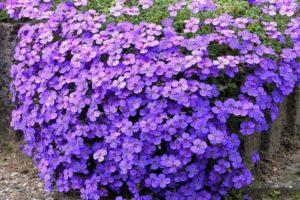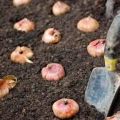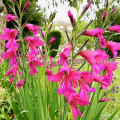Reasons why gladioli do not bloom, methods of treatment and prevention
Gladioli are garden decoration. Breeders have bred varieties with different shapes and colors of petals. But sometimes the sight of gladioli disappoints the gardener, since the plants may not form a flower arrow all summer. Or on the formed peduncle, the buds dry out without blooming. Further information on why gladioli do not bloom, what is the reason, and how to correct mistakes in care.
Possible causes of color problems
There may be several reasons why gladioli do not bloom. Having identified the mistakes and correcting them, the gardener will grow spectacular plants with gradually blossoming buds on his site.
Poor quality planting material
When purchasing planting material from random sellers, the gardener may not wait for the blooming of gladioli. Too young plants will not bud. The bulb must first grow in volume, get stronger. Only after that is she ready to extend the flower arrow. If large corms have not bloomed, they may be infected with pathogenic microorganisms, pests. In addition, you need to purchase varieties of gladioli adapted to the region in which the gardener lives. For example, in cold areas, late-ripening plants may not have time to bud.
Note! The peculiarity of some varieties of gladioli is that after flowering, they need 1-2 years to rest.
Wrong landing site
The bulbs are planted in a well-lit area. In the shade, the bloom of gladioli may not come. In partial shade, plants do not give a beautiful arrow: it will form a thin, curved one.

The landing site must be ventilated. If the plants are too close to each other and there is no ventilation, there is a possibility of fungal infection. In addition, the territory for planting gladioli needs to be changed every 2 years.
Failure to comply with landing rules
A culture is planted on the site after the earth warms up to 10 ° C. When performing the procedure, the following rules are observed:
- planting depth on heavy soils is 3 bulb diameters;
- on the lungs - 4 diameters.
If the plant is too deep, the development of the gladiolus is delayed; this year it may not release a peduncle. One more rule must be observed: young and adult plants are planted separately. Otherwise, large gladioli will hammer the children, prevent them from fully developing.
Important! To prevent infection of corms with diseases and pests, the grooves are watered with Fitosporin before planting.
Weather
Plants react to the lack of moisture in the ground, as well as to its excess. In hot, dry weather, the culture is watered after 2-3 days. If gladioli grow on a hill, they will need daily irrigation.
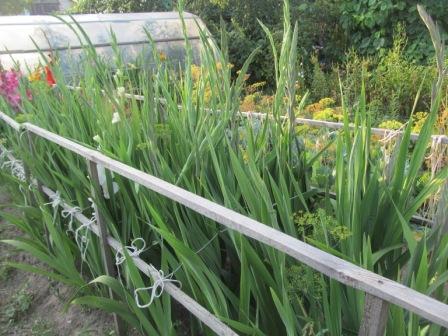
Frequent rainfall and abundant watering contribute to the appearance of fungal diseases. Plants weakened by pathogenic microorganisms do not form a peduncle.
Improper care
In order for gladioli to bloom beautifully and profusely, they need to be properly cared for. It is as follows:
- The bulbs are fed several times during the season. Lack of nutrition leads to the fact that the plant loses its immunity, is exposed to the invasion of diseases and pests. Weakened bushes are difficult to form and dissolve buds.
- The crust formed after watering prevents soil aeration. To get the air deep, the soil around the plants is loosened.
- The plot is sprinkled with mulch. It helps to preserve moisture in the soil and controls the temperature balance. In addition, mulch prevents nutrients from leaching out of the soil.
- So that next season the bulb can also grow a peduncle, after the buds dry this year it is cut off. At the same time, at least 4 leaves are left, since through them the underground part of the plant is fed.
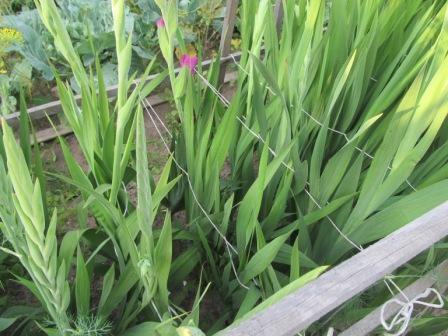
Note! Mowed grass, straw, peat are used as a mulching material.
Diseases and pests
The flowering of gladioli is highly dependent on the presence of diseases and pests.
Fusarium
The disease is caused by a fungus. It enters the soil through an infected bulb, and is also formed due to abundant watering of plants, excessive feeding. With fusarium, the bulbs are covered with brown spots, the aerial part grows poorly. The leaves turn yellow prematurely, the flower arrow does not form.
Important! The infected area is treated with fungicides, gladioli are planted on it after 5 years.
Thrips
Small insects pierce the tissue, suck out cell sap from stems and leaves. Thrips multiply rapidly: from spring to autumn, 9 generations of insects can develop. The pest penetrates into the bud, affects it. Then it gradually creeps into the ground, destroying the corm. To prevent the appearance of thrips, the plant is treated with Karbofos.
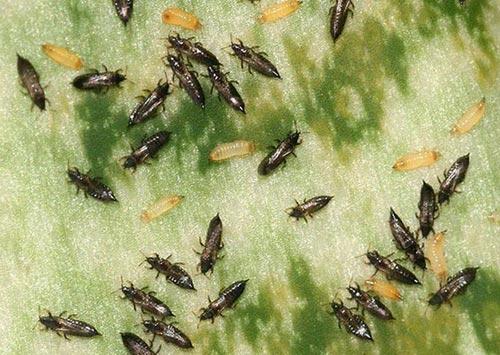
Wireworm
The larva of the click beetle usually affects young gladioli. The wireworm makes holes in the bulb; if the ground is dry, it gnaws at the core of the stem. The pest loves to appear in a weedy area. Therefore, around gladioli, plant residues are carefully removed, especially wheatgrass grass. For bait, cut raw vegetables can be placed in the ground: carrots, potatoes, beets.
Onion root mite
The pest enters the site with seed. It penetrates into the bulb, gradually thinning it. It multiplies quickly in high soil moisture. In plants weakened by the pest, buds do not bloom or do not form at all. Get rid of the root mite by spraying the seed with acaricide.
Conclusion
Gladioli are beautiful garden plants. The flower arrow forms buds, the color and shape of which depends on the variety. But sometimes flowering may not come.
Having studied the information about the causes of problems with plants, correcting mistakes, the gardener will grow spectacular gladioli on the site, opening their buds over several summer days.

